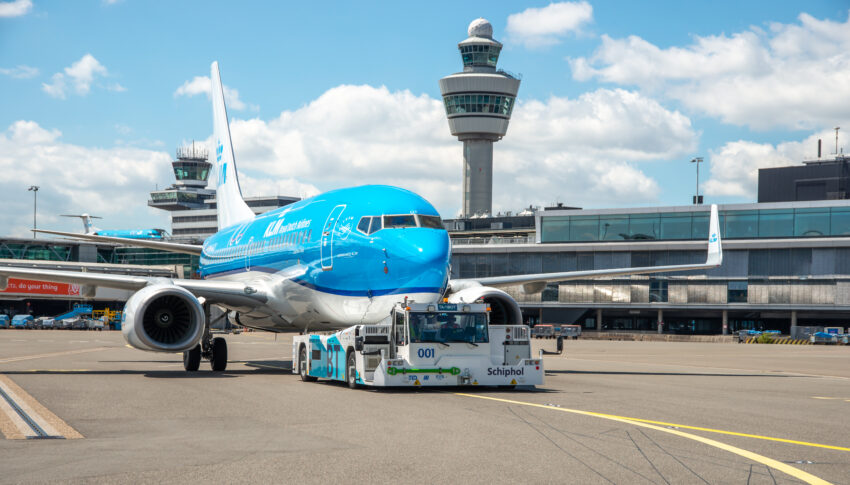As aviation looks to reduce its fuel consumption — and thus emissions — at altitude, the industry is also examining similar efforts at ground level. An early trial of more sustainable autonomous airport taxiing robots at Amsterdam Schiphol is posing some particularly thought-provoking questions. They’re called TaxiBots, and we sat down with an airport spokesperson to learn more.
“The TaxiBot is a special towing vehicle that transports aircraft between the gate and the runway,” Schiphol’s spokesperson tells us. “It’s different from other towing vehicles, as the TaxiBot is able to taxi the aircraft at close to normal speed and slow it down in a safe way. During taxiing, the TaxiBot is controlled by the pilot and not the person inside the vehicle. The driver only connects the TaxiBot to the aircraft and carries out the pushback in a way similar to current procedures. The aircraft pilot then takes control as soon as the taxiing procedure starts.”
The aircraft engines are kept off for as long as possible for fuel savings. Schiphol’s early pilot testing programme in 2020 suggested that using the saved approximately 50% of the total fuel required to taxi, increasing to 65% when aircraft used the infamously remote Polderbaan runway, some five kilometres from the main terminal area.
Since the TaxiBot is powered by hybrid diesel-electric engines, it also reduces the local effects of fine and ultra-fine particle emissions, nitrogen, and carbon dioxide when compared with aircraft engines burning aviation kerosene. That’s good for the wider environment and for the airport’s neighbours.
With four-wheel-steering, the TaxiBot can line up and remain in the correct position vis-à-vis the aircraft. The pilot steers the TaxiBot using the aircraft’s normal ground controls. Braking uses the main landing gear initially, after which the TaxiBot brakes. This allows the system to avoid unacceptably high loads on the nose landing gear, which has been a problem in previous ground towing tests.
All the way back in 2006, Virgin Atlantic conducted trials at Heathrow and Gatwick airports to use standard tugs for taxiing to takeoff, which the airline estimated could save up to two tonnes of fuel per Boeing 747-400 per flight. Trials were, regrettably, abandoned after advice from the airframer that the nose gear were not designed for such extended-use structural load, far beyond the normal pushback operations.
“We are currently working hard with our sector partners to find a solution for many of the previously identified obstacles,” Schiphol tells us, noting that “the current TaxiBots are certified for use with Airbus A320 family aircraft, as well as Boeing 737 family aircraft.”
With over 170 tests conducted across more than 25 days of testing at daytime and during the night, and including periods of de-icing training by the airport’s main hub airline KLM, the trial provided a substantial amount of data.
“The sustainable taxiing trial went very well and we learned about the advantages,” the airport concludes. “However, we also learned that although it is possible to implement sustainable taxiing at Schiphol, there are several prerequisites that are not yet being met, in the areas of operations, infrastructure and technology.”
On the operational side, these include changes to checklists, protocols for communication and similar procedures, together with pilot and driver training. The various locations for coupling and uncoupling may also require changes in the way that airport traffic circulates, and how air traffic control manages those changes.
In terms of infrastructure, new hard surface roads are required and additional markings will be needed at the coupling and uncoupling locations, while technically the TaxiBot itself needs some revision: it is too wide for some airport infrastructure and isn’t fully cross-compatible across all aircraft types.
But progress is promising, and the airport is planning to take part in a further, pan-European project in 2023 involving multiple TaxiBots at the airport.
Author: John Walton
Published: 1st September 2022




